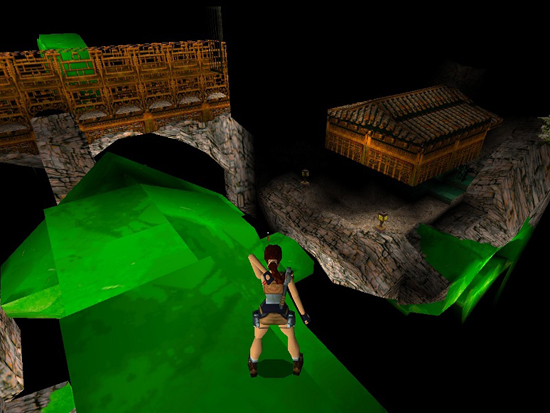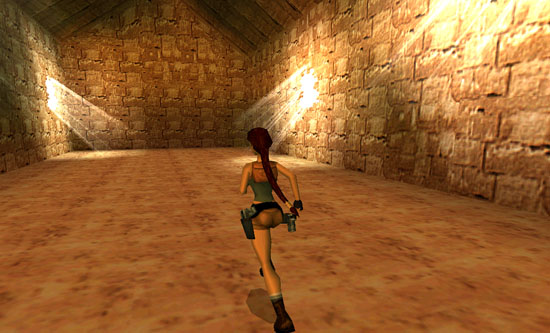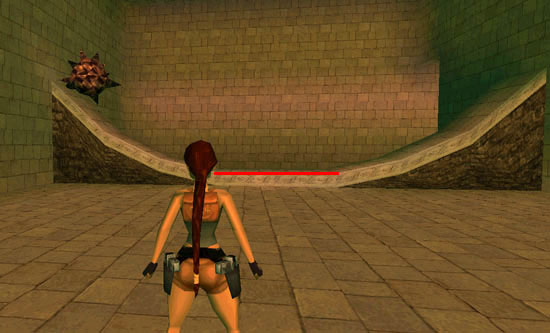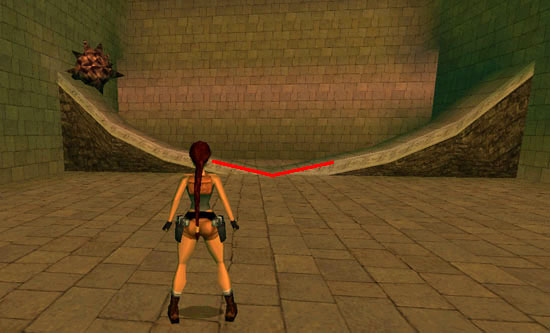The classic Tomb Raider engine is far from depicting a physically correct world. Lara jumps further and higher than any Olympic champion, huge stone blocks get pushed around easily, water waves look more like a foil than real water…
But it is not necessary for good gameplay to rebuild the natural world perfectly. Breaking the rules intentionally can be interesting in terms of atmosphere and gameplay.

If you want to build a level as realistic as possible, you should try to avoid some substantial mistakes as long as the engine allows it. Many players will not even notice it. But you can use realism as a base for puzzles very well. It is a personal choice. This tutorial is not meant to be an instruction but as a food for thought. Of course it makes no claim to be complete.
Connected Waterrooms
Fluids have some properties that seem intuitively strange. One example are the communicating vessels. All vessels/rooms get the same water level when they get connected.

This seems simple, but it is often forgotten. The reason for this behavior is is actually quite complicated: The pressure at the bottom of a water-filled vessel is only dependent on the water level, but not dependent on the filled volume and the geometry of the vessel. But we should not go into detail here. Important is the consequence: Even a huge water tank will have the same water level as a thin pipe that is connected to the tank.

Sinks
Sinks are a popular game element. But how do you build them more or less realistically? It is also not intuitively clear how sink velocities change with room geometries.
Let us take a tube that reduces its width. Will the water flow with the same speed, slower or faster?

It flows faster. The speed is inversely proportional to the width. This seems strange. Where does this acceleration come from? The reason is that fluids are (nearly) not compressible. Thus the same amount of fluid flows through every part of the tube. If the width is reduced, the pressure and speed increases.
Water and Ice
What about this puzzle: You have to melt a free swimming block of ice to increase the water level. Sorry, but this is unrealistic. The water level will be exactly the same after melting. Ice has a smaller density and bigger volume, but the same mass as in the fluid state. The buoyant force is the same as the mass which is displaced by the body.
By the way, the difference in density of water and ice is not that big. Only 15% of an iceberg emerge from the water.

Laser beams 
Hollywood shows us beautiful laser beams in clean galleries, even in the daylight. But this is bullshit. You should not see anything (except a small point on a wall). There is a good reason why fog machines are used in clubs. The light is scattered at the particles, so they can reach our eye. If a light beam is not scattered it travels past the eye, thus it is invisible for us.
In Tomb Raider Legend this was used for a puzzle.

By the way: It is not very clever to use laser light from the visible spectral range for motion detectors. Thus infrared light is used. Does this make gameplay with laser light completely impossible? Of course not. It is all a question of creativity. There are games which take this into account.
Decorative light beams
Light beams that fall into rooms through the roof or windows have the same problem. The rooms should ideally be dusty or foggy, if the effect should look realistically.
The light beams should come out of the same direction within a level, or at least within an room. The sun will not change its position drastically. This looks nice, but could only happen on Tatooine:

The rollingball and conservation of energy
The rollingball is one of the few parts of the classic Tomb Raider engine with a somewhat realistic physics engine. This is why you have to test it elaborately, so it goes along the intended path. But there is a rub. The rollingball loses energy only on flat floor structures. In reality, the permanent friction with the floor would lead to a continous energy loss. Normally this property does not get noticed. However, in symmetrical paths it becomes very clear.

The rollingball behaves nearly realistically due to the flat area. It will lose height with every passage and will finally stop in the middle.

In this case, the rollingball will oscillate infinitely and reach the same height every time. This looks really weird. However, this property is very handy, because you can use the rollingball as a trigger for cyclic events.
The rollingballs has some other oddities. For example the initial drop height does not contribute to its potential energy. Thus it will roll up to the same point on a ramp if you drop it from one, four or eight clicks height. You should start the rollingball on the ramp, if you want a realistic look.
Another weird behaviour occurs on symmetrical ramps without flat areas and with increasing slopes on both sides. I made the observation that it will always turn around on the three-click ramp, even if it started higher, but I am not sure, if this is true in every environmet.
Contest: